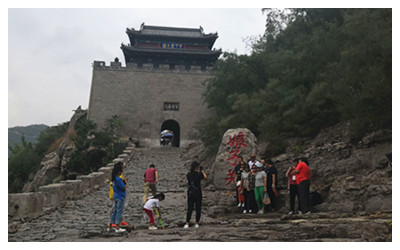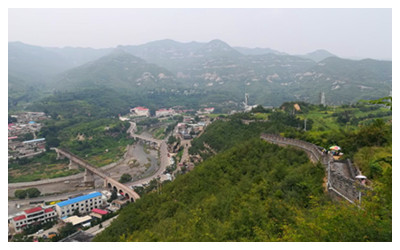Skype: neodalle-travel
Tel: +86 135 7447 2266
E-mail: sales@visitaroundchina.com
Niangzi Pass or Niangziguan Great Wall, is located in northeast Pingding County of Yangquan City, where Shanxi Province meets Hebei Province. The present Niangzi Pass was built in 1542 during the Ming Dynasty (1368-1644), constructed against the Mianshan Mountain in the east, with the Taohe River flowing to its west. Due to its strategic location, the Niangzi Pass was always the key-point of battle in ancient times. Moreover, it is known as the "Ninth Pass under Heaven".
History
Historically, it was called Weize Pass, meaning a pass with reeds and marshes. Later, Princess Ping Yang, the sister of Emperor Taizong of the Tang Dynasty (618-907), commanded a group of women soldiers to bravely guard the pass. Hence, it was renamed "Niangzi Pass", which literally means a pass guarded by women.
What to see?
Niangzi Pass
Nowadays , if you come here, you can see the magnificent South Gate (Inner Gate), East Gate (Outer Gate), and one section of the Great Wall.
, if you come here, you can see the magnificent South Gate (Inner Gate), East Gate (Outer Gate), and one section of the Great Wall.
Steep Steps of the PassIn front of the South Gate is a horse track paved with smooth pebbles. Looking up, you can find four impressive Chinese characters "Jing Ji Fan Ping", meaning a protective defense of the capital. There is a grand double-eave gate tower. During wartime, the gate tower served as the command post. Nowadays, there is a sitting statue of Princess Ping Yang in uniform. She holds a sword, and looks very gallant. Over the eave hangs a tablet which reads "Ninth Pass under Heaven". Standing on the gate tower, you have a panoramic view of the pass and the nearby Taohe River.
The east gate is carved with "Zhi Li Niang Zi Guan", which means that the pass is under the direct control of the capital city. At one time, there was a platform above the gate for inspecting a military parade. Today, a gate tower has been built.
To the east of the South Gate is the Great Wall snaking up the Mianshan Mountain. It is 710 yards (650 meters) long, with crenels along the outer side. The Great Wall is quite narrow and precipitous. Handrails have been provided for your convenience.
Niangziguan Village
 After visiting the pass, you can walk about 15 minutes to see the village. It is said that residents here are the offspring of soldiers who used to guard the pass. The water village is characterized by stone houses, crisscrossing streams, and bubbling springs. You can see many water mills grinding flour. More importantly, you can experience the peaceful lifestyle of the locals. Women are washing vegetables and clothes in the streams; children are running around happily; the elderly are sitting under grape trellises, leisurely playing chess. In addition, you can see many traditional Chinese houses with three or four courtyards. Also, there are some ancient buildings, including an old stage, Bell Tower, and Temple of Guan Yu (a loyal and righteous general).
After visiting the pass, you can walk about 15 minutes to see the village. It is said that residents here are the offspring of soldiers who used to guard the pass. The water village is characterized by stone houses, crisscrossing streams, and bubbling springs. You can see many water mills grinding flour. More importantly, you can experience the peaceful lifestyle of the locals. Women are washing vegetables and clothes in the streams; children are running around happily; the elderly are sitting under grape trellises, leisurely playing chess. In addition, you can see many traditional Chinese houses with three or four courtyards. Also, there are some ancient buildings, including an old stage, Bell Tower, and Temple of Guan Yu (a loyal and righteous general).
Shuiliandong Waterfall
Endowed with both cultural relics and beautiful scenery, the Niangzi Pass is really worth visiting. After a visit to the village, you can go to see the Shuiliandong Waterfall, which is about 550 yards (500 meters) to the southeast of the East Gate of the pass. The waterfall is 7 yards (6.5 meters) wide, with a fall of 130 feet (40 meters). The waterfall pours down from the cliffs and splashes the stones. "Shuiliandong" literally means Water Curtain Cave. From the name, you can imagine what a big waterfall it is!
Travel Tips
Address: Pingding county,Yangquan city, Shanxi province
Tel: 0350-4785315
Opening Hours: 08:00-17:30
Entrance Fees: CNY 40
 Ask Questions ?
Ask Questions ?